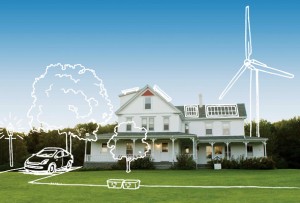How the North Shore is protecting Mother Earth and its bottom line.
By Beth Daigle
Photographs by Robert Boyd
Illustration by Joe Mckendry
Remember when conserving energy meant turning out the lights? The trend of “going green” has given new meaning to the idea of doing your part. But do you know all that it encompasses? Businesses, schools, and residents throughout the North Shore are making impressive strides in the effort to protect the environment and achieve sustainability with long-term savings-and they’re doing it without staging protests or sit-ins.
“Reduce, Reuse, Recycle”
For most people, a natural first step in protecting the environment is to take part in town-wide recycling programs. Improved curbside pick-up initiatives have made it easier than ever to reduce household waste and jump on the recycling bandwagon.
According to John Wood, facility manager of Waste Management Recycle America in Lawrence, “the move to singlestream recycling [where participants combine glass, metals, paper, etc. into one receptacle] has increased volume an average of 30 percent.” Recycle America works with North Shore towns like Ipswich and Gloucester, encouraging customers to “reduce, reuse, recycle.” Wood says that diverting recyclable material from a landfill can save businesses and households thousands of dollars and in some cases, rebates are paid for the commodities delivered.
E-cycling is one of Recycle America’s latest initiatives. The plan takes e-scrap, or discarded computers, monitors, cell phones, video games, etc., and diverts them from landfills. This, in turn, minimizes the potential leaching of toxic metals, like lead, cadmium, and mercury into nearby ecosystems. In partnership with companies like LG Electronics and Sony, Recycle America has created programs that take back as much as 10 million pounds of e-waste per outreach. Taking advantage of these programs will be of critical importance as technology upgrades result in more and more e-scrap.
Green Energy
Beyond recycling and waste reduction lies the commitment to reduce energy consumption and carbon footprints. Companies like Nexamp of North Andover have developed turnkey solutions to assist their customers with renewable energy, sustainable solutions, and energy management. Nexamp has successfully turned its own workplace into a “beyond zero net-energy” environment which produces more energy than it consumes. Free home assessments determine the energy efficient options that are feasible for potential residential customers. Solar photovoltaics (PV), solar thermal, wind, and geothermal options are just some of the opportunities available from Nexamp that can help homeowners reduce their carbon emissions and embrace an eco-friendly lifestyle.
“Our mission is to help our customers become their own utility,” Nexamp President Daniel Leary explains, “to make clean energy simple and profitable.” Additionally, Leary reports that, “typical residential customers with solar PV projects have about a nine percent annualized return on their investment.” Customers might also benefit from a 50 percent reduction in their electric bill.
From the Ground Up
Brian Palm, Chair of Science Department at Brooks, explains that in an effort to create a physical and mental connection between the inside and outside, the space was designed around a 150-year old oak tree which stands outside the second floor sitting area. In addition, interior benches and signage were constructed from walnut trees milled directly from the site. The science building is automatically monitored and regulated based on outside temperatures to ensure that the in-floor radiant heating and natural gas-fired heating system are operating at a minimal level. “The building operates at about 33-35 percent less energy usage than a normal building of the same size,” Palm says. “We are lighting the building with about .75 watts per square foot. A good green building will be 1 watt per square foot.”
The science building’s “living roof ” hosts 45 native plants and acts as a storm water management system. What would otherwise simply be a typical asphalt roof is transformed into a biologically diverse habitat that encourages life and growth. The vantage point from the roof reveals a man-made, wet-dry garden that handles run-off that eventually filters through the living roof. Both the living roof and the garden provide function as well as unique scenic value.
Eco-Lifestyle
Businesses and schools across the North Shore are not alone in their desire to promote change. Residents are embracing the ideology as well, driven by concerns surrounding rising energy costs, foreign fuel dependency, natural resource scarcity, and global warming. Movement towards the purchase of hybrid vehicles and organic products are on the rise along with the desire for green renovations and green design. Green design products and materials including paint, organic fabrics, and sustainable furniture have all become more readily available to customers looking for alternative, zero VOC (volatile organic compounds) options.
Circle Furniture of Danvers is committed to preservation and conservation. The company is a founding member of the Sustainable Furniture Council, a non-profit coalition of industry players created to promote sustainable practices among manufacturers, retailers, and consumers. Circle’s raw materials are selected from forests that are managed according to strict environmental standards. “Even our floor coverings and hi-tech, media storage pieces come from factories that are friendly to Mother Earth,” says Circle Senior Design Consultant Christine Carine Cellucci.
Little Things Matter
While the possibilities may seem overwhelming, taking small steps in the right direction is also worthwhile. Simple changes like replacing incandescent light bulbs with energy efficient fluorescents, drinking from reusable water bottles, turning the water off when brushing teeth, unplugging appliances and electronics, and returning your plastic grocery bags to the store are all important ways to preserve our earth’s natural resources and save, both environmentally and financially. Education is also paramount. Conditioning our youth to make good recycling decisions and environmentally correct choices will naturally progress us to an improved environmental state for the future.


